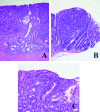Beta-Catenin mutations in a mouse model of inflammation-related colon carcinogenesis induced by 1,2-dimethylhydrazine and dextran sodium sulfate
- PMID: 15723650
- PMCID: PMC11159258
- DOI: 10.1111/j.1349-7006.2005.00020.x
Beta-Catenin mutations in a mouse model of inflammation-related colon carcinogenesis induced by 1,2-dimethylhydrazine and dextran sodium sulfate
Abstract
In a previous study, we developed a novel mouse model for colitis-related carcinogenesis, utilizing a single dose of azoxymethane (AOM) followed by dextran sodium sulfate (DSS) in drinking water. In the present study, we investigated whether colonic neoplasms can be developed in mice initiated with a single injection of another genotoxic colonic carcinogen 1,2-dimethylhydrazine (DMH), instead of AOM and followed by exposure of DSS in drinking water. Male crj: CD-1 (ICR) mice were given a single intraperitoneal administration (10, 20 or 40 mg/kg body weight) of DMH and 1-week oral exposure (2% in drinking water) of a non-genotoxic carcinogen, DSS. All animals were killed at week 20, histological alterations and immunohistochemical expression of beta-catenin, cyclooxygenase (COX-2) and inducible nitric oxide synthase (iNOS) were examined in induced colonic epithelial lesions (colonic dysplasias and neoplasms). Also, the beta-catenin gene mutations in paraffin-embedded colonic adenocarcinomas were analyzed by the single strand conformation polymorphism method, restriction enzyme fragment length polymorphism and direct sequencing. The incidences of colonic neoplasms with dysplastic lesions developed were 100% with 2.29+/-0.95 multiplicity, and 100% with 10.38+/-4.00 multiplicity in mice given DMH at doses of 10 mg/kg or 20 mg/kg and 2%DSS, respectively. Although approximately half of the mice given DMH at a dose of 40 mg/kg bodyweight were dead after 2-3 days after the injection, mice who received DMH 40 mg/kg and 2%DSS had 100% incidence of colonic neoplasms with 9.75+/-6.29 multiplicity. Immunohistochemical investigation revealed that adnocarcinomas, induced by DMH at all doses and 2%DSS, showed positive reactivities against beta-catenin, COX-2 and iNOS. In DMH/DSS-induced adenocarcinomas, 10 of 11 (90.9%) adenocacrcinomas had beta-catenin gene mutations. Half of the mutations were detected at codon 37 or 41, encoding serine and threonine that are direct targets for phosphorylation by glycogen synthase kinase-3beta. The present results suggests that, as in the previously reported model (AOM/DSS) our experimental protocol, DMH initiation followed by DSS, may provide a novel and useful mouse model for investigating inflammation-related colon carcinogenesis and for identifying xenobiotics with modifying effects.
Figures





Similar articles
-
Colonic adenocarcinomas rapidly induced by the combined treatment with 2-amino-1-methyl-6-phenylimidazo[4,5-b]pyridine and dextran sodium sulfate in male ICR mice possess beta-catenin gene mutations and increases immunoreactivity for beta-catenin, cyclooxygenase-2 and inducible nitric oxide synthase.Carcinogenesis. 2005 Jan;26(1):229-38. doi: 10.1093/carcin/bgh292. Epub 2004 Sep 30. Carcinogenesis. 2005. PMID: 15459021
-
A novel inflammation-related mouse colon carcinogenesis model induced by azoxymethane and dextran sodium sulfate.Cancer Sci. 2003 Nov;94(11):965-73. doi: 10.1111/j.1349-7006.2003.tb01386.x. Cancer Sci. 2003. PMID: 14611673 Free PMC article.
-
Altered expression of beta-catenin, inducible nitric oxide synthase and cyclooxygenase-2 in azoxymethane-induced rat colon carcinogenesis.Carcinogenesis. 2000 Jul;21(7):1319-27. Carcinogenesis. 2000. PMID: 10874009
-
Gene mutations and altered gene expression in azoxymethane-induced colon carcinogenesis in rodents.Cancer Sci. 2004 Jun;95(6):475-80. doi: 10.1111/j.1349-7006.2004.tb03235.x. Cancer Sci. 2004. PMID: 15182426 Free PMC article. Review.
-
Dextran sulfate sodium-induced colitis-associated neoplasia: a promising model for the development of chemopreventive interventions.Acta Pharmacol Sin. 2007 Sep;28(9):1450-9. doi: 10.1111/j.1745-7254.2007.00695.x. Acta Pharmacol Sin. 2007. PMID: 17723178 Review.
Cited by
-
Chromatin-associated APC regulates gene expression in collaboration with canonical WNT signaling and AP-1.Oncotarget. 2018 Jul 27;9(58):31214-31230. doi: 10.18632/oncotarget.25781. eCollection 2018 Jul 27. Oncotarget. 2018. PMID: 30131849 Free PMC article.
-
Inducible heat shock protein 70 prevents multifocal flat dysplastic lesions and invasive tumors in an inflammatory model of colon cancer.Carcinogenesis. 2009 Jan;30(1):175-82. doi: 10.1093/carcin/bgn256. Epub 2008 Nov 12. Carcinogenesis. 2009. PMID: 19005184 Free PMC article.
-
Cardiac and gastrointestinal liabilities caused by deficiency in the immune modulatory enzyme indoleamine 2,3-dioxygenase.Cancer Biol Ther. 2011 Dec 15;12(12):1050-8. doi: 10.4161/cbt.12.12.18142. Epub 2011 Dec 15. Cancer Biol Ther. 2011. PMID: 22157149 Free PMC article.
-
Isomaltooligosaccharides inhibit early colorectal carcinogenesis in a 1,2-dimethylhydrazine-induced rat model.Front Nutr. 2022 Sep 15;9:995126. doi: 10.3389/fnut.2022.995126. eCollection 2022. Front Nutr. 2022. PMID: 36185671 Free PMC article.
-
Targeted deletion of the metastasis-associated phosphatase Ptp4a3 (PRL-3) suppresses murine colon cancer.PLoS One. 2013;8(3):e58300. doi: 10.1371/journal.pone.0058300. Epub 2013 Mar 28. PLoS One. 2013. PMID: 23555575 Free PMC article.
References
-
- Van Hogezand RA, Eichhorn RF, Choudry A, Veenendaal RA, Lamers BHW. Malignancies in inflammatory bowel disease: Fact or fiction? Scand J Gastroenterol 2002; 235: (Suppl.) 48–53. - PubMed
-
- Weitzman SA, Gordon LI. Inflammation and cancer: role of phagocyte‐generated oxidants in carcinogenesis. Blood 1990; 76: 655–63. - PubMed
-
- Warren BF, Watkins PE. Animal models of inflammatory bowel disease. J Pathol 1994; 172: 313–6. - PubMed
-
- Mori H, Ohbayashi F, Hirono I, Shimada T, Williams GM. Absence of genotoxicity of the carcinogenic sulfated polysaccharides carrageenan and dextran sulfate in mammalian DNA repair and bacterial mutagenicity assays. Nutr Cancer 1984; 6: 92–7. - PubMed
Publication types
MeSH terms
Substances
LinkOut - more resources
Full Text Sources
Other Literature Sources
Molecular Biology Databases
Research Materials

